We will see how we are going to create space and score the goals, will it be against the low block or will there be other opportunities in the game when it is a little bit more open? We are looking more at how we are going to create space on Sunday.’ This was Renee Slegers’ response on Friday afternoon to a question about playing against West Ham’s low defensive block on Sunday.
Arsenal’s issues with low defensive blocks over the last 18 months or so have, I think, caused many of us to characterise the majority of the teams that Arsenal play as ‘low block’ teams. But I don’t think that is always the case. Slegers hinted on Friday that she didn’t expect Sunday’s hosts to be in a low block at all times and she was right. Let’s look at some examples of how Arsenal tried to expose West Ham when they weren’t camped in their penalty area.
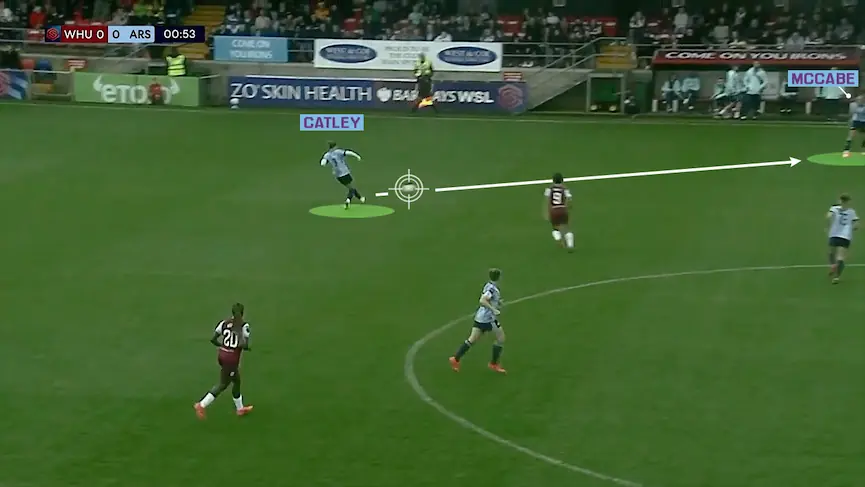
One of Arsenal’s preferred manoeuvres on the day was to try to ‘work the channels.’ The first time that Arsenal play out here, Catley passes the ball wide to McCabe.
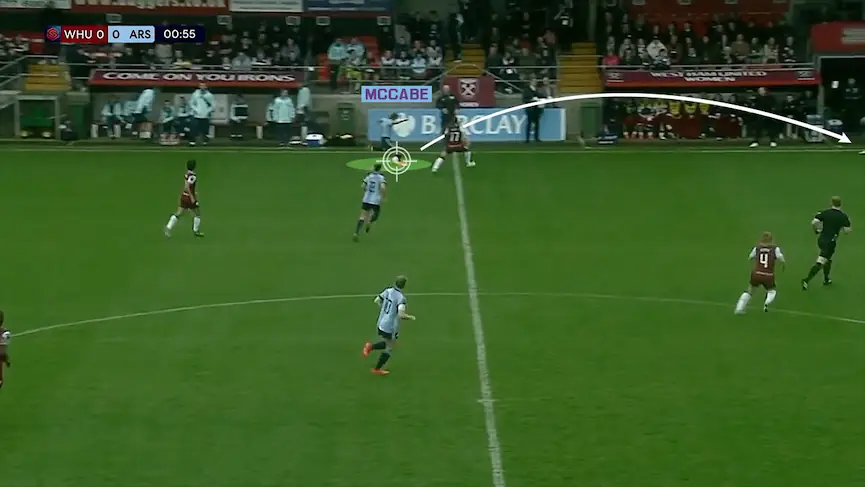
McCabe receives and immediately whips the ball into the channel. Keep this in mind when we unpick Arsenal’s opening goal.
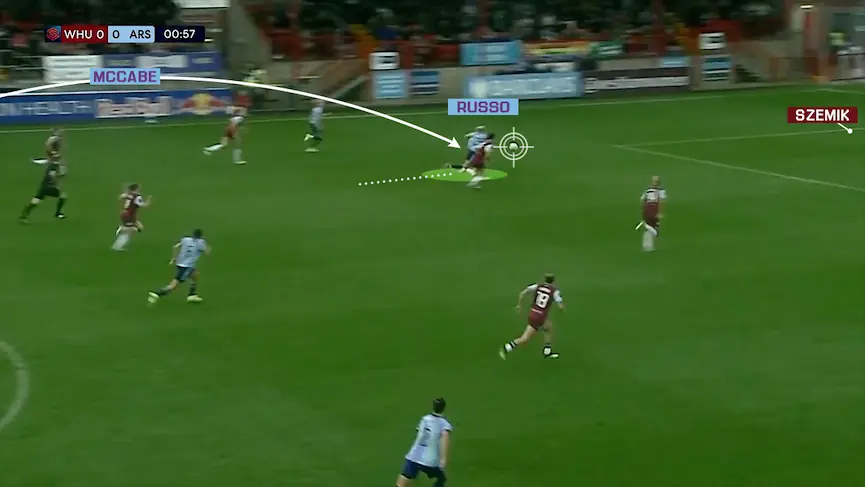
McCabe’s whipped pass gives Russo something to chase. On this occasion, Szemik is out to intercept but Arsenal used this manoeuvre a few times during the game. West Ham have conceded a lot of goals this season due to balls played between their full-backs and centre-halves.
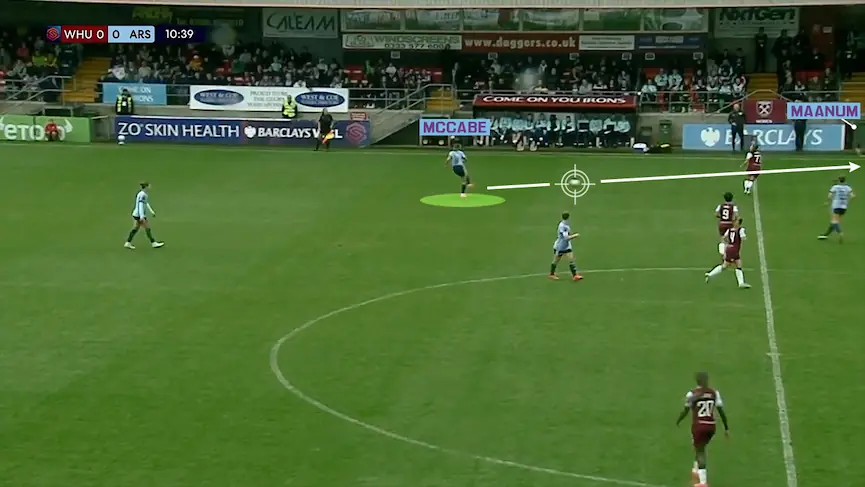
The idea was to play the ball ASAP in this space to catch West Ham off guard before they reassembled into a deep block. McCabe finds Maanum here.
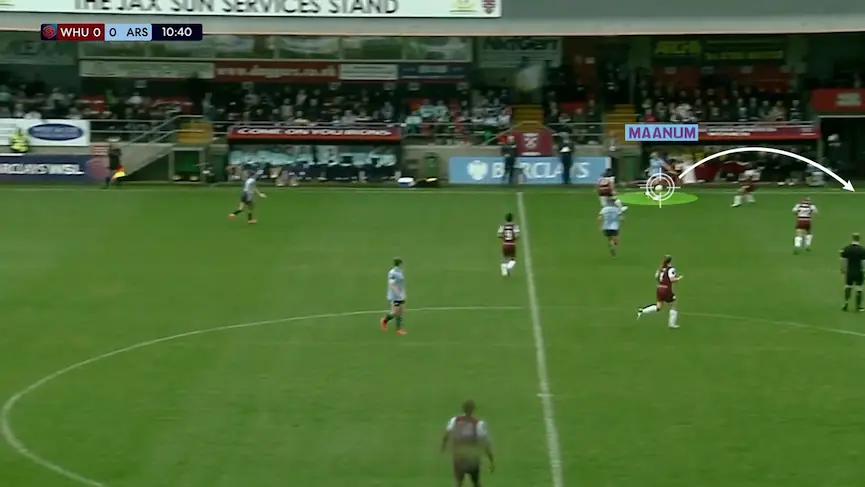
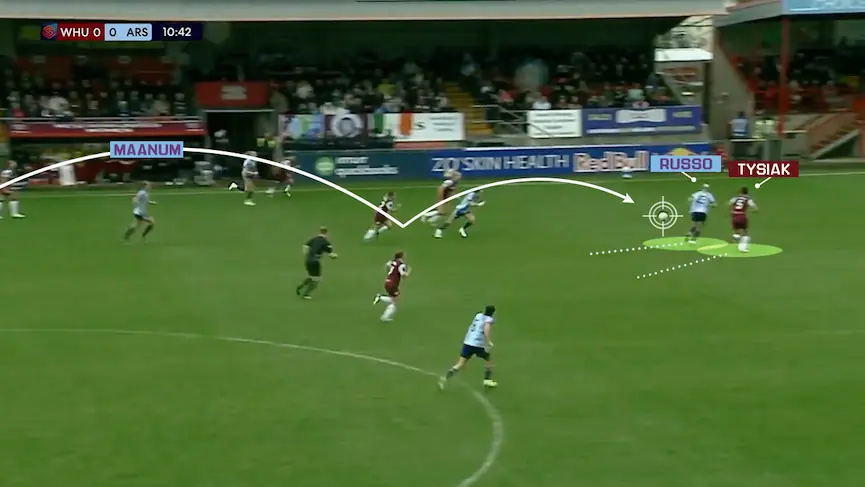
Frida doesn’t delay, she clips the ball first time into the channel and Tysiak is in a foot race with Russo. Tysiak gets a last ditch challenge in on this occasion, which could easily have been given as a foul. The sequence does end with Arsenal’s first shot of the game from Maanum. But you can see where Arsenal think they can create some space, as Slegers spoke about on Friday.

When the ball moved into Arsenal’s defensive third, regardless of whether West Ham or Arsenal had the ball there, West Ham’s defensive line squeezed very high and Arsenal wanted to exploit this with quick balls over the top too. van Domselaar is a superior long kicker to Zinsberger which probably goes into why she retained her place for this game.
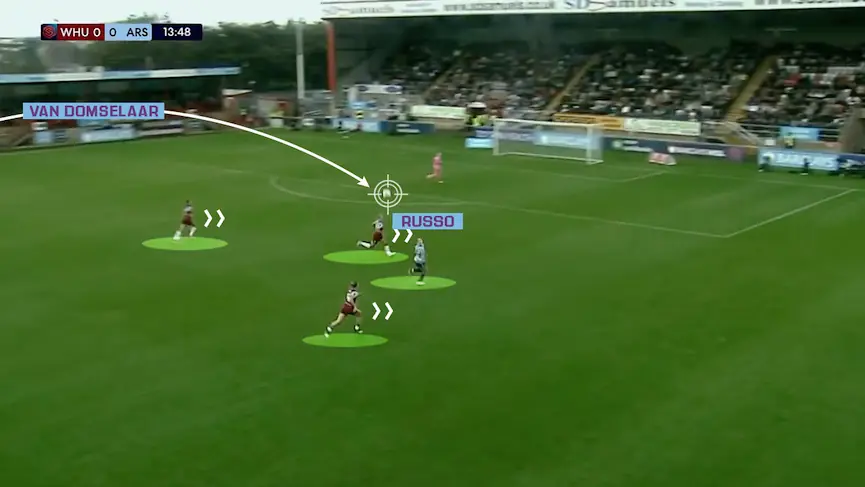
Van Domselaar pings a long ball to Russo and you can see that West Ham are not exactly assembled in a deep block here, there are three defenders in the picture and they are all sprinting backwards.
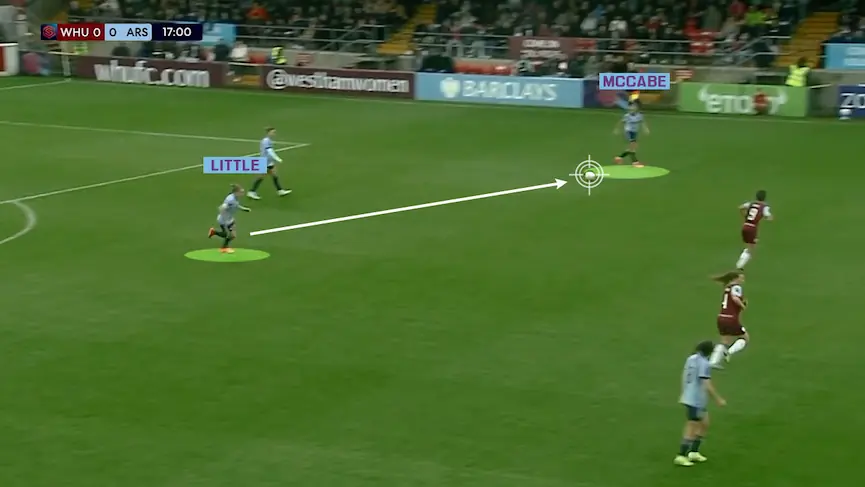
Little passes the ball to McCabe here and she doesn’t show to get the ball back because she knows what is going to happen next.
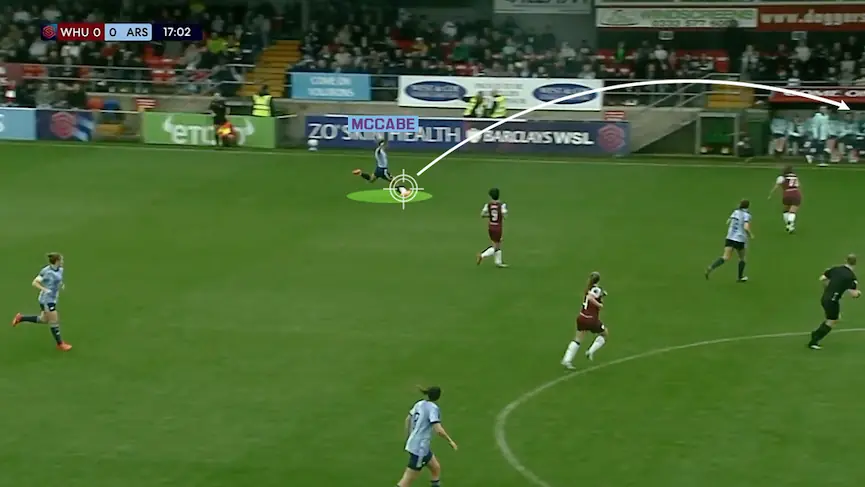
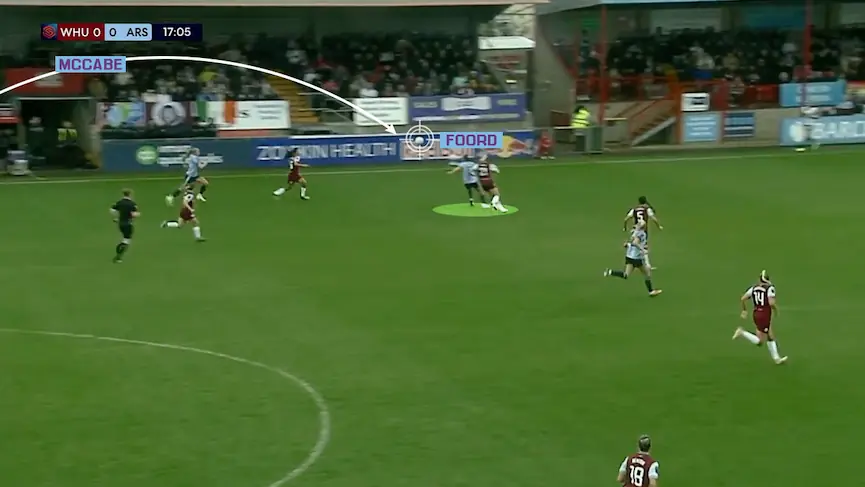
Arsenal were pretty consistently able to play over West Ham’s high line when the Gunners played out from the back and find their forwards in good positions and build from there.

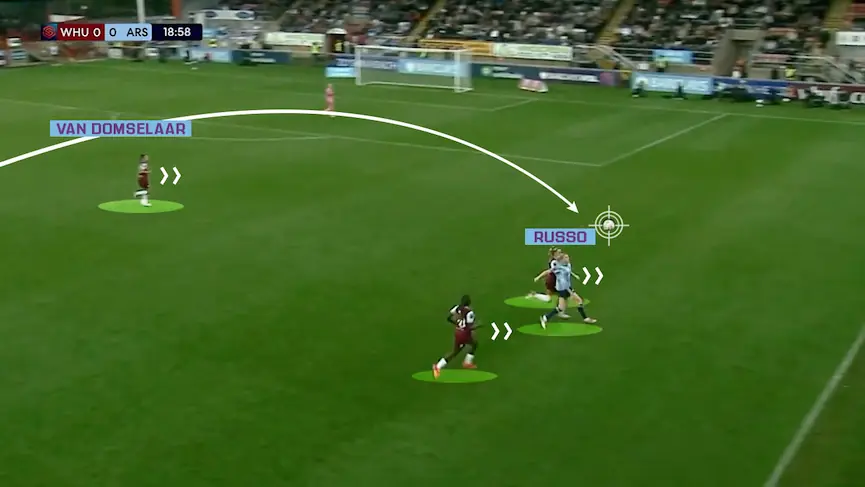
Arsenal often looked to play into space when the West Ham line squeezed up and they did it reasonably well but, in truth, they struggled to create many meaningful openings from that platform in the first half. The wind was incredibly strong in the stadium and it was against Arsenal in the first half.
The camera angles from the coverage don’t really show it but I tweeted in the stadium to demonstrate how much the West Ham line squeezed up when the ball was at the other end of the pitch.
There’s a bit of a tendency to characterise most of Arsenal’s opponents as ‘low block’ teams but this is not a low block. In this phase of play West Ham not in a low block at all. pic.twitter.com/I0SDCMKAHc
— Tim Stillman (@Stillmanator) October 20, 2024
I asked Slegers about this after the game and she said, ‘they are very compact between their lines but you can see they play a high line at times without much pressure on the ball, we thought the space would be behind their lines. You see that especially in the first half that we tried to play into that.’

Arsenal win a free-kick as Piubel fouls McCabe here and McCabe is on her feet ASAP to take it quickly.
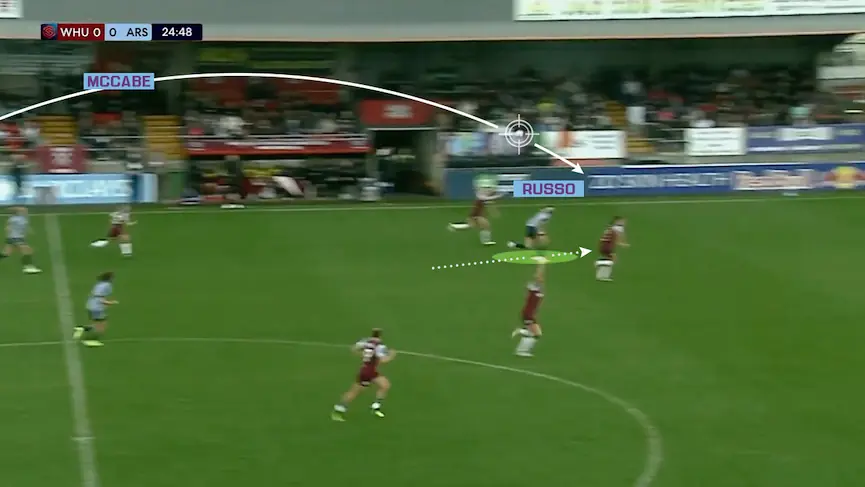
And Russo is poised in the channel to run onto McCabe’s free-kick. The speed is the key, Arsenal by no means just pumped the ball into the channels for the whole game but when they were able to do it quickly before West Ham’s high line could drop, they went for this option on often on the left side, which probably explains why Foord played on the left and Mariona on the right in the first half.
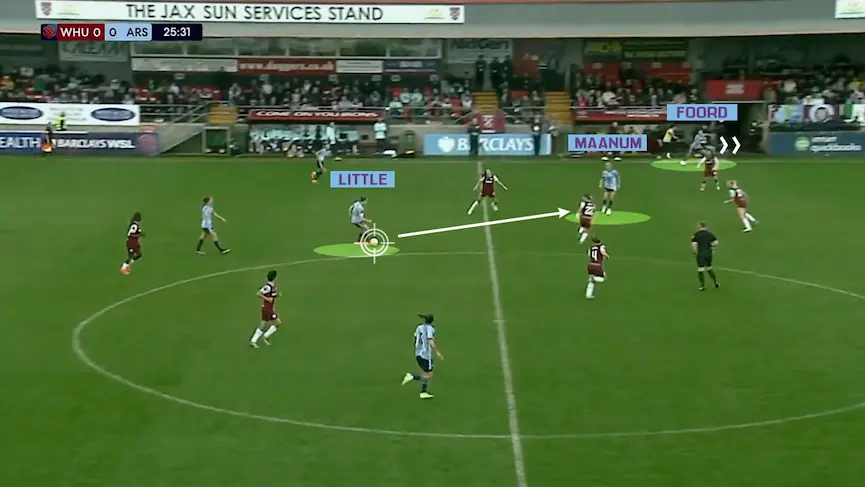
It wasn’t just a case of being direct or from back to front either. As Little carries the ball in midfield here, she finds Maanum in the pocket and we can see Foord is interested in exposing West Ham’s high line in behind.
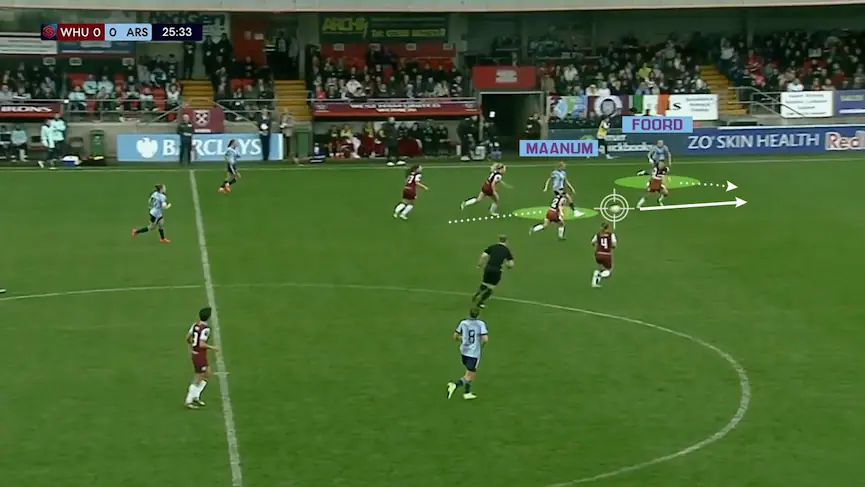
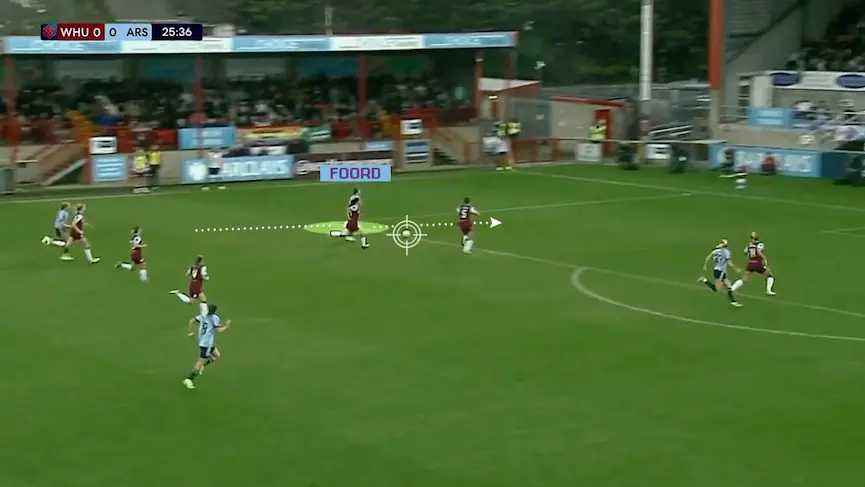
Maanum finds Foord and once again, Arsenal have found space in that channel.

You can see that Arsenal are becoming more certain that they can expose West Ham on their right side, as Catley gets the ball here you can see what is unfolding.

It’s a really good pass that causes West Ham a bit of panic again as Foord runs onto it. At the risk of labouring the point, this is not what a deep block looks like.

Here is another example from the right side. Van Domselaar bowls the ball out to Emily Fox.
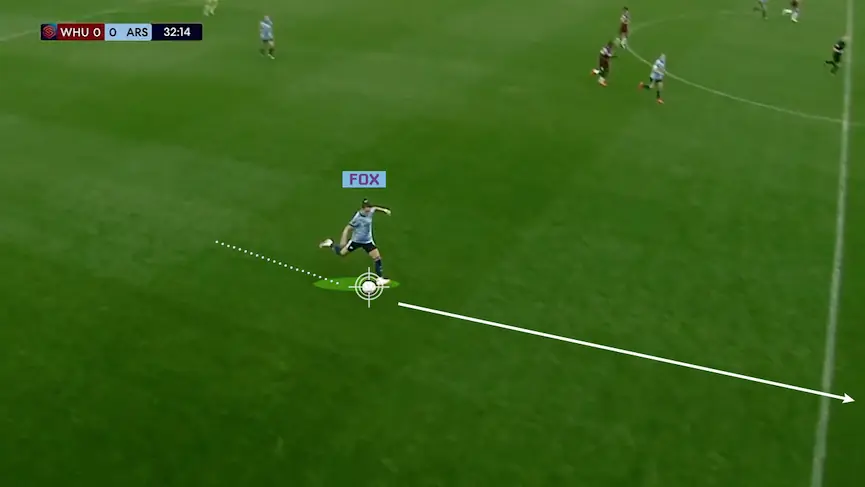

And Fox finds Russo in a good position with West Ham’s defensive line squeezed up again. This is the space Slegers was talking about in her Friday press conference, clearly.
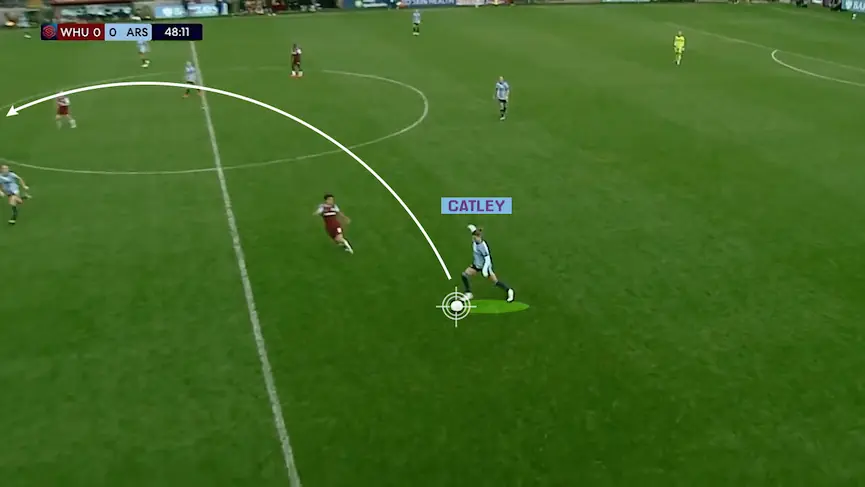
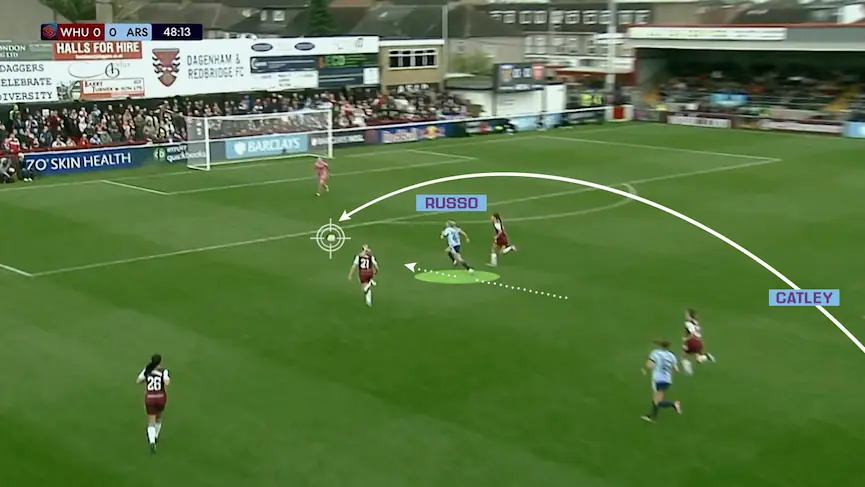
You can see early in the second half that the tactic doesn’t deviate. It does perhaps beg the question as to why Stina Blackstenius didn’t start the game given her strength at running in behind. Her introduction made a huge difference.
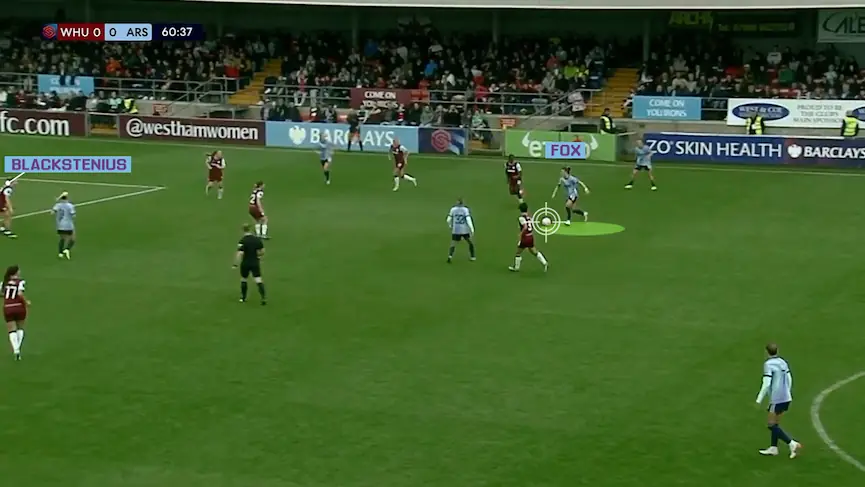
The difference with Stina is that she makes the runs a little higher up the pitch (which is part of the reason she is often caught offside). As Fox looks for a pass here, Stina hits the channel a little later in the move than Arsenal had been doing it previously.
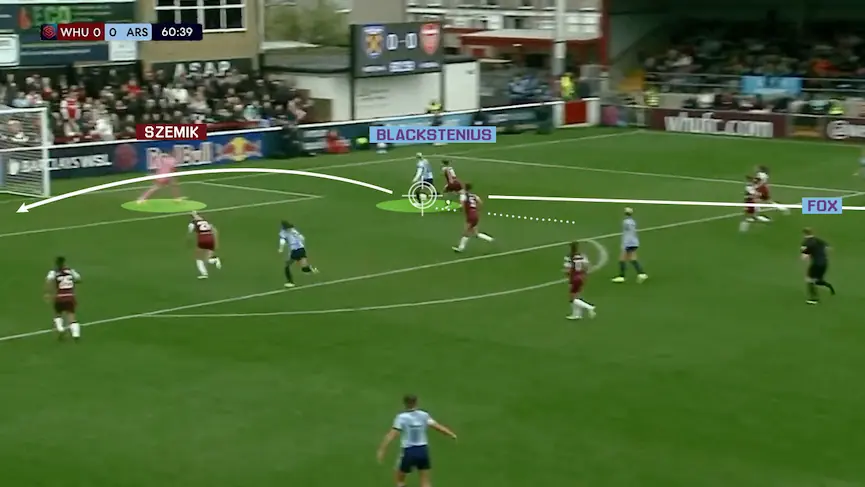
Within 90 seconds of entering the pitch, Blackstenius has the best chance of the game. Szemik just glances this effort and it rolls inches wide.
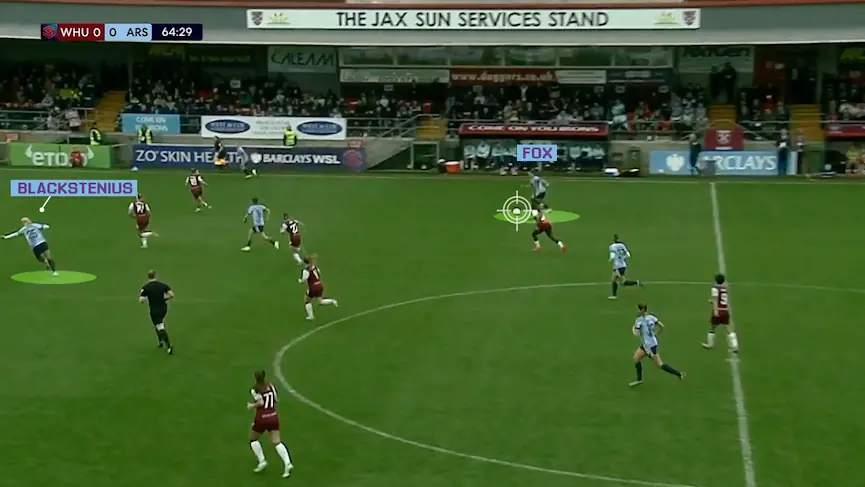
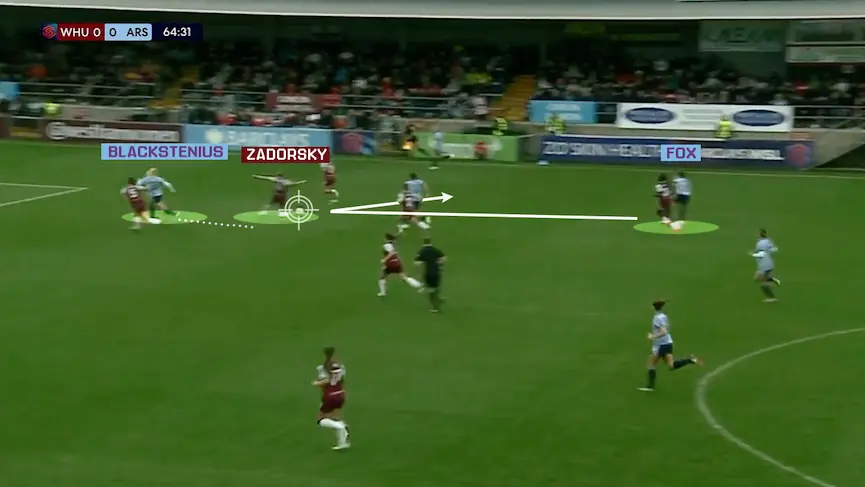
This pass from Fox doesn’t quite make it but, again, we see Stina willing to test that channel in more high value positions for Arsenal.

It all comes together for the penalty that gives Arsenal their opener. Catley passes to McCabe here.
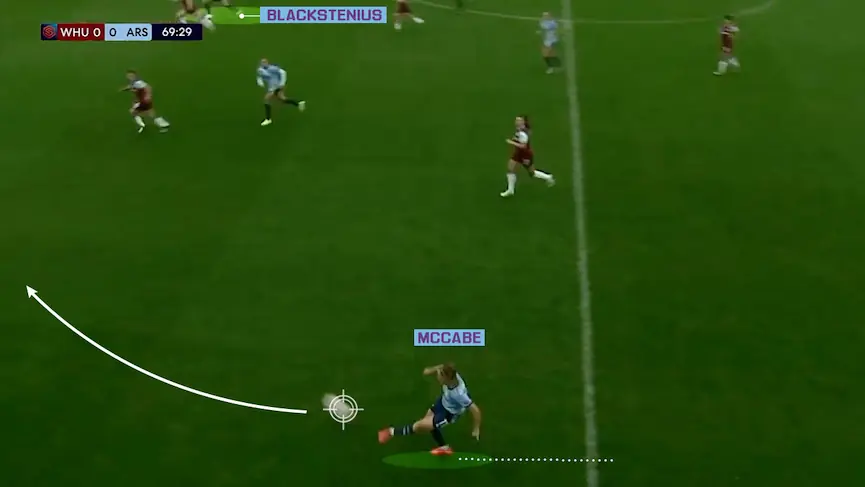
McCabe has time and space and controls the ball and sends it straight into the channel.

Blackstenius is a willing runner and Tysiak is exposed, panics and takes her out in the area. In fact, a second before this, Shannon Cooke toys with pulling Stina back on the edge of the area too. Mariona converts the spot kick.
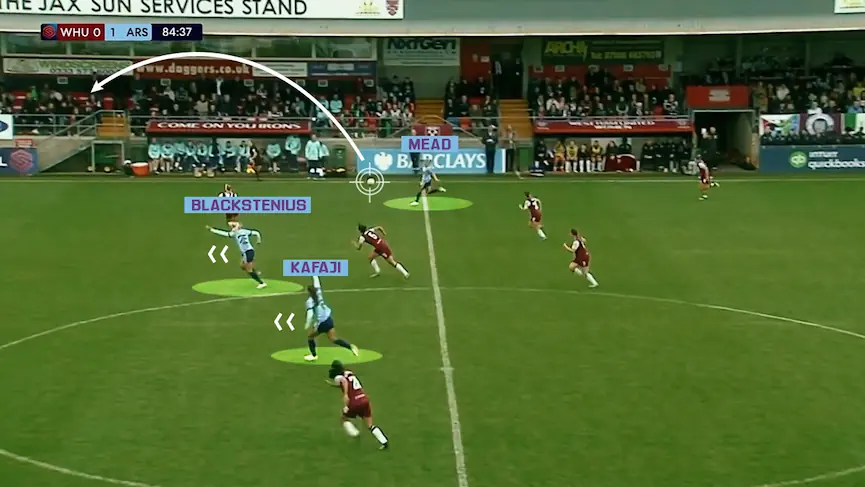
As the ball breaks to Mead here, we see Blackstenius and Kafaji are interested and though they are chasing an equaliser at this stage, it is again worth reiterating that West Ham’s defensive line is very high. Mead duly plays the pass and Stina goes through one-on-one and really ought to score.
While the game state is instructive here, Arsenal do get their killer second goal and, again, it is via a Blackstenius run into the channel. Arsenal plugged away at that space for the entire game so it was no surprise that both their goals came from that avenue. It is perhaps just a little surprising that Blackstenius didn’t start the game given her suitability to that particular assignment.
Rosa Kafaji rounds off a precise team move with a clean first-time strike 🧼#BarclaysWSL @ArsenalWFC pic.twitter.com/gZ7rigE1uI
— Barclays Women's Super League (@BarclaysWSL) October 20, 2024





I keep reiterating, Arsenal’s squad is of great quality, and one more thing, Van Donselllar’s distribution of the ball was incredible, sometimes giving us chances for counterattacks, it seems she improved very quickly in this regard.
I think that people who vote in ratings in on-line polls such as the BBC, and people who comment, have an unconscious bias in what they see sometimes. There was so much praise for Rosa Kafaji, and I agree that she ought to play more. I’d like to see her bring a bit of chaos to opposing defences. But the game-changer after the substitutions was Stina, even if she didn’t always get it right. Without her, that was a 0-0 draw, despite a PoTM performance from Mariona.
Interesting, thanks. Simple but effective idea. I could see that we were going for the channels a lot and we had quite a lot of nearly moments. Many was the time I said, as the ball looped over the press and into space for Russo or Foord to chase, “That’s a Stina ball.” But we got there in the end. Stina is clumsy, has a very inconsistent first touch, a wayward passer at times but she is fast and induces panic in the opposition defence. What pleased me about the attempt she made from a tight angle (and nearly scored… Read more »
I do not agree with the sentiment that Kafaji should play more or every game anymore than Stin, Russo, Foord, Williamson or aany others. ALL these players to some degree suit a different opposition, other issues so like most other managers, Renee made the subs at the right time and used the right players aginst West Ham. another fixtire may have seen a different strting and finishing eleven but well done team. Good result.
Isn’t shuffling the ball up the touch line Arsenal’s only strategy for every single game? Ball either goes to Foord or Mead and then they hope to get a cross in or get a corner. The midfield too slow to get into the box and make triangles to drive the ball from the wings. Arsenal can’t drive the ball up the middle either. Walti or Little just pass it back or give it to Foord and Mead for the same strategy to start again. Watch 79-80th minute when they played against chelsea where everyone funnels the ball back to Williamson… Read more »